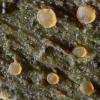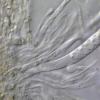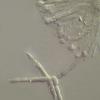
26-11-2025 18:13
The entire run of Mycotaxon is now available throu

25-11-2025 14:24
Thomas Læssøehttps://svampe.databasen.org/observations/10490522

25-11-2025 11:03
Mick PeerdemanHi all,One of my earliest microscopy attempts, so

24-11-2025 15:23
Arnold BüschlenHallo, auf einer offenen Kiesfläche am Rande ein

23-11-2025 11:16
Bohan JiaHi, I found small discs growing on dead stem of

21-11-2025 10:56
 Christopher Engelhardt
Christopher Engelhardt
Very small (~0,5 mm) white ascos, found yesterday
Orbilia with 'hyphomycete'
Chris Yeates,
05-08-2013 19:28
 Bonsoir tous
Bonsoir tousyesterday I collected a damp rotten decorticated branch (probably Taxus); there are several species of fungi on it; one is an Orbilia which I feel reasonably confident is O. eucalypti - I have collected this species in this wood before, though on a different substrate (see: http://www.ascofrance.com/search_forum/21451 )
Of interest was a conidium of a sort one often associates with aquatic, Ingoldian, fungi - we have had a lot of rain recently and I have noticed conidia normally though of as primarily aquatic in wet terrestrial habitats). The conidium a strong resemblance to Tripospermum camelopardus, although it has an extra "neck" - because of the three-dimensional nature of the condium I have tried (not entirely successfully I fear)? to use stacking software to give an idea of its size and point of attachment (it is the upper left "neck" in the attached image). If it is a Tripospermum, then there clearly is no link between the two fungi (that genus is anamorphic Capnodiaceae); but I may be wrong in assigning it there. I know Zotto is interested in putative anamorphs of Orbilia (some of which do have potentially aquatic anamorphs). Others may be interested too, so I post this find here.
Cordialement
Chris
Hans-Otto Baral,
05-08-2013 21:52

Re : Orbilia with 'hyphomycete'
Hi Chris
the conidium does not look orbiliaceous. The kind of branching is unusual. The filament to the right is the conidiophore? Dies it have a faint colour or is it from Congo red?
Yes, this is the sublobose-spored variant of eucalypti, certainly geneticaly not different because sometimes also normal asci and spores are found in the same population.
Zotto
the conidium does not look orbiliaceous. The kind of branching is unusual. The filament to the right is the conidiophore? Dies it have a faint colour or is it from Congo red?
Yes, this is the sublobose-spored variant of eucalypti, certainly geneticaly not different because sometimes also normal asci and spores are found in the same population.
Zotto
Chris Yeates,
05-08-2013 22:34

Re : Orbilia with 'hyphomycete'
Thanks for the confirmation Zotto; with regard to the conidium, no, all the "arms" are part of it (and no stain, must be an artefact - it was difficult to render this in 2 dimensions); I have since checked Prof. Ingold's protologue for Tripospermum camelopardus (see attached); this conidium quite strongly resembles his undescribed T. sp. As you can see the original point of attachment is the shorter of the "giraffe's" two legs.
So certainly an unconnected stray . . . .
best wishes
Chris
So certainly an unconnected stray . . . .
best wishes
Chris
Hans-Otto Baral,
05-08-2013 22:37

Re : Orbilia with 'hyphomycete'
Yes, you are certainly right!
Zotto
Zotto
Esquivel-Rios Eduardo,
05-08-2013 23:20
Re : Orbilia with 'hyphomycete'
"Tripospermun myrti (Lind). Hughes. 1951. Mycol. pap. 46:17-18
Conidia with stalk cell 6-10 x 4- 7 mu, arms up t0 30 mu long, 4-8 thick at the base,tapering 1-2 mu, 1 - 4 septate, often constricted at the septa; one of the arms in this species usually lies parallel to the stalk cell"
Conidia with stalk cell 6-10 x 4- 7 mu, arms up t0 30 mu long, 4-8 thick at the base,tapering 1-2 mu, 1 - 4 septate, often constricted at the septa; one of the arms in this species usually lies parallel to the stalk cell"





 1968-v51-p51-0001.pdf
1968-v51-p51-0001.pdf